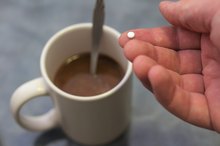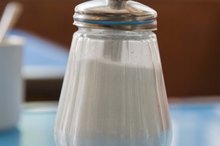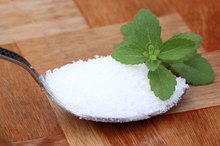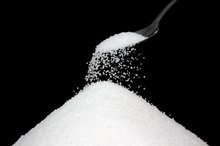What does fact checked mean?
At Healthfully, we strive to deliver objective content that is accurate and up-to-date. Our team periodically reviews articles in order to ensure content quality. The sources cited below consist of evidence from peer-reviewed journals, prominent medical organizations, academic associations, and government data.
The information contained on this site is for informational purposes only, and should not be used as a substitute for the advice of a professional health care provider. Please check with the appropriate physician regarding health questions and concerns. Although we strive to deliver accurate and up-to-date information, no guarantee to that effect is made.
Stevia & the Atkins Diet
Altering metabolism through diet manipulation is an effective way to lose unwanted weight. Several diet systems, including the Atkins Diet, claim sugar substitutes aid the body’s fat burning process by reducing the total amount of carbohydrates available for fuel 1. While many sugar substitutes are available for use, sugar substitutes such as Stevia are gaining popularity.
Stevia
For centuries, Japan and other countries outside of the U.S. have used Stevia (pronounced ste-ve-uh) for medicinal purposes and as a natural herbal sweetener. Native to Central and South America, the leaves of the Stevia Rebaudiana Bertoni bush produce extracts known as Rebaudioside A (Reb A) and stevioside. Purified Reb A-based sweeteners are used as an ingredient in foods and beverages such as Sprite Green, Sobee Lifewater and Celestial Seasonings Antioxidant Green Tea. The extracts are 200 to 300 times sweeter than sugar. Stevia is available in both powder and liquid forms.
- For centuries, Japan and other countries outside of the U.S. have used Stevia (pronounced ste-ve-uh) for medicinal purposes and as a natural herbal sweetener.
- Purified Reb A-based sweeteners are used as an ingredient in foods and beverages such as Sprite Green, Sobee Lifewater and Celestial Seasonings Antioxidant Green Tea.
Safety
Fructose-Free Diet
Learn More
After years of scientific and public scrutiny, the World Health Organization’s (WHO) Joint Expert Commission on Food Additives concluded in June of 2008 that highly purified stevia extracts were safe for use as general purpose sweeteners. This endorsement was echoed in the July 2008 issue of “Food Chemistry Toxicology,\" adding that it must be “produced to food-grade specifications and according to good manufacturing practices” for safe human consumption. On December 17, 2008, the FDA placed Reb-A on its GRAS list (Generally Regarded as Safe). Approval was given exclusively to Cargill, makers of Truvia, and Merisant, makers of PureVia, to mass-market stevia as a sweetener.
- After years of scientific and public scrutiny, the World Health Organization’s (WHO) Joint Expert Commission on Food Additives concluded in June of 2008 that highly purified stevia extracts were safe for use as general purpose sweeteners.
- This endorsement was echoed in the July 2008 issue of “Food Chemistry Toxicology,\" adding that it must be “produced to food-grade specifications and according to good manufacturing practices” for safe human consumption.
Atkins Plan
The Atkins Diet plan is based on a progression through four phases of carbohydrate restriction 1. Phase one, the Induction Phase, restricts carbohydrate consumption to 20g per day. Vegetables provide the main source of carbohydrate. Phase two, the Ongoing Weight Loss Phase, allows a weekly increase of carbohydrates in the form of fiber and nutrient-rich selections. When weight loss plateaus, carbohydrates are cut back by 5g each week until weight loss resumes. Phase Three, the Pre-Maintenance Phase, allows a 10g increase in carbohydrates each week as long as very gradual weight loss continues. The Lifetime Maintenance Phase, Phase Four, encourages a variety of food selections while controlling carbohydrate intake.
- The Atkins Diet plan is based on a progression through four phases of carbohydrate restriction 1.
- Phase two, the Ongoing Weight Loss Phase, allows a weekly increase of carbohydrates in the form of fiber and nutrient-rich selections.
Recommendations
Saccharin Safety in Toothpaste
Learn More
Table sugar is limited to three teaspoons per day during all four phases of the Atkins Diet 1. Non-caloric sweeteners must be limited to three packets per day and counted as1g of carbohydrate. Dr. Atkins suggests trying all types of non-caloric sweeteners based on personal taste and tolerance. Stevia is a highly concentrated sweetener; therefore, it is good to be aware of the appropriate substitutions. This will enhance tolerance and the outcome in recipes. Two to three drops of liquid stevia is equivalent to one teaspoon of sugar. One half packet or 3/8 teaspoon of powdered stevia is equivalent to one teaspoon of sugar. More detailed conversion information is available online.
- Table sugar is limited to three teaspoons per day during all four phases of the Atkins Diet 1.
- Non-caloric sweeteners must be limited to three packets per day and counted as1g of carbohydrate.
Caution
Stevia is a safe substitute for sugar. It can be used during all four phases of the Atkins Diet 1. However, consumers should be aware of the limitations associated with long-term use of low-carbohydrate diet plans such as Atkins 1. In a 2007 issue of Journal of the American Medical Association, lead researcher Dr. Christopher Gardener said that although weight loss was more effective in individuals following a less-than-20g-of-carbohydrate-per-day diet than higher carbohydrate levels, there was no significant difference after 12 months 1. Therefore, keeping total daily carbohydrate intake at no less than 45 percent of daily calories is suggested.
Related Articles
References
- The Atkins Diet
- Low-carb diet: Can it help you lose weight? Mayo Clinic. https://www.mayoclinic.org/healthy-lifestyle/weight-loss/in-depth/low-carb-diet/art-20045831?pg=2.
- Phase One List of Acceptable Foods. Atkins. https://www.atkins.com/how-it-works/atkins-20/phase-1/low-carb-foods.
Resources
Writer Bio
Based in Northwestern Pennsylvania, registered dietitian Michele Frndak has educated the public about food and human behavior since 1981. A nutrition coach and community food advocate, Frndak holds a Master of Science degree in human nutrition from the University of Alabama. Her online articles reflect a passion for well-being through nutritional health.









